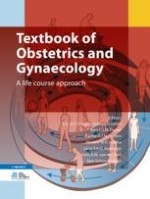Summary
Foetal-to-neonatal transition during labour and just after birth is an intricate phenomenon in which many processes are involved. It is a vulnerable period for the newborn and perinatal mortality remains an important contributor to overall mortality and morbidity, despite improvements in foetal and neonatal care. In this chapter, the physiology of transition and potential diseases of the neonate are discussed. Important hallmarks of cardiopulmonary transition are the switch from foetal to postnatal circulation and aeration of the lungs, which also interact with each other. As perinatal asphyxia is an important risk factor for perinatal mortality and morbidity, neonatal resuscitation and pathophysiology of perinatal asphyxia are extensively discussed. The preterm born infant can encounter problems as a consequence of immaturity, such as respiratory distress syndrome and intraventricular haemorrhage. Insight into the physiology of transition at birth and the pathophysiology of common neonatal diseases is essential to improve neonatal and long-term outcome.
